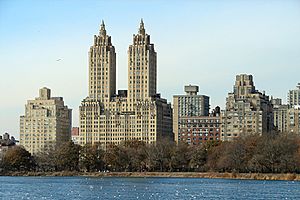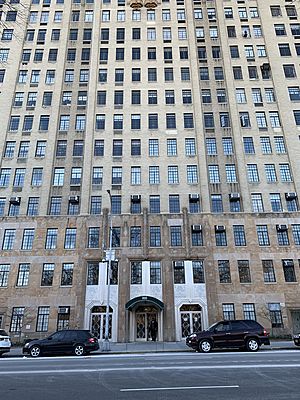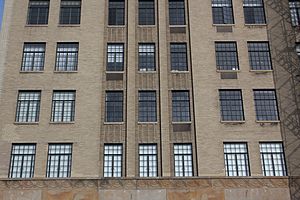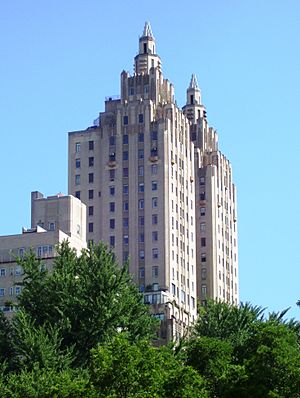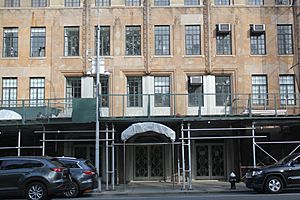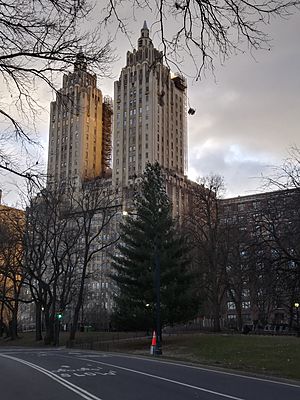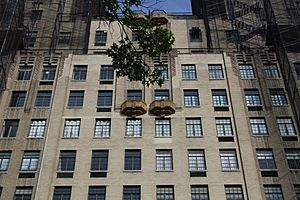The El Dorado facts for kids
|
The El Dorado
|
|
|
U.S. Historic district
Contributing property |
|
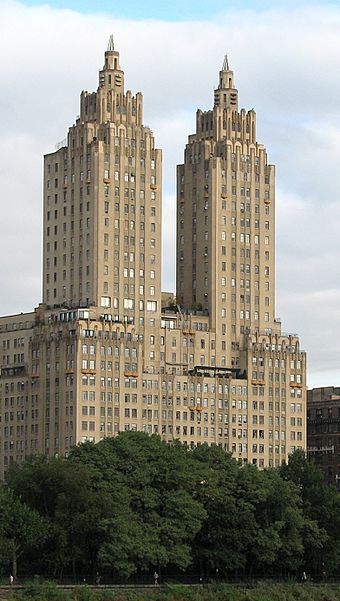
The El Dorado
|
|
| Built | 1929–1931 |
|---|---|
| Architect | Emery Roth |
| Architectural style | Art Deco |
| Part of | Central Park West Historic District (ID82001189) |
Quick facts for kids Significant dates |
|
| Added to NRHP | November 9, 1982 |
The El Dorado is a special kind of apartment building called a cooperative. It is located at 300 Central Park West in Manhattan, New York City. It sits between 90th and 91st Streets, right next to Central Park. The building was constructed from 1929 to 1931. It was designed by architects Margon & Holder and Emery Roth in the Art Deco style. The El Dorado is 30 stories tall. It has two towers that rise from a 19-story base. The building is an important part of the Central Park West Historic District. This district is listed on the National Register of Historic Places. The El Dorado is also a special New York City designated landmark.
The lower part of the building has several "setbacks." These are steps in the building's shape. They were added to follow the city's building rules from 1916. The two towers rise from the eastern side of the building, above the 19th floor. On Central Park West, the first three floors are covered in a material called cast stone. The main entrance has three cool, angled bronze archways. The rest of the building is made of tan and brown bricks. These bricks are arranged to make the building look very tall. Some apartments on the upper floors have angled stone balconies. The very tops of the towers have special sculpted decorations called "finials." When the El Dorado first opened, it had 200 apartments with 1,500 rooms. Some apartments have been changed since then. The main lobby is decorated with marble. A gym was added in the building's two basement levels in the 1990s.
The current El Dorado building replaced an older apartment complex. That complex was built in 1902 and was also called the El Dorado. The new building was constructed by a developer named Louis Klosk. He started building in 1929 but could not finish after the Wall Street Crash of 1929. A company called Central Park Plaza Corporation bought the El Dorado in 1931. Over the years, different companies and people owned the building. In 1953, a pastor named Charles M. "Daddy" Grace bought it. His estate later sold it in 1960. The El Dorado became a housing cooperative in 1982. This means the residents own shares in the building. Many parts of the building were updated after this, even with some disagreements among residents.
Contents
Where is the El Dorado Located?
The El Dorado Apartments are located at 300 Central Park West. This is in the Upper West Side area of Manhattan, New York City. The building is on the west side of Central Park West. It sits between 90th Street to the south and 91st Street to the north. The land the building is on is almost square. It covers about 39,765 square feet. The building faces Central Park West for 200 feet. It also faces 90th Street for 200 feet and 91st Street for 194 feet. It is directly across from the Jacqueline Kennedy Onassis Reservoir in Central Park.
The El Dorado is one of several apartment buildings on Central Park West that have a special name. Even though a street address is enough, this was a British custom. Buildings on Fifth Avenue, on the other side of Central Park, are usually known by their addresses. An expert named Christopher Gray said the El Dorado has a "glitzy" name. The name comes from an older building that was on the same spot.
What Was There Before?
Building Central Park in the 1860s led to lots of construction on the Upper East Side. But development on the Upper West Side was slower. Big buildings started appearing after the Ninth Avenue elevated train opened in 1879. This train made it easy to get to Lower Manhattan. The first large apartment building in the area was the Dakota, which opened in 1884. The city added power lines to Central Park West in the late 1800s. This allowed for taller apartment hotels with elevators to be built.
One of these early apartment hotels was the first El Dorado. It was built between 90th and 91st Street. This original El Dorado was an eight-story apartment complex. It was finished in 1902. It was designed by Neville & Bagge. It had two separate buildings with 50 apartments. Each apartment had between four and fifteen rooms. There was also a garage and a charging station for early electric cars. The building even had outside turrets. One newspaper called it "the most notable apartment house on Central Park." But another newspaper said it looked like a typical "moderate-rent apartment house."
The El Dorado's Design
The current El Dorado was built from 1929 to 1931. Louis Klosk was the developer. The company Margon & Holder was the main architect. Emery Roth was a consulting architect, meaning he gave advice. Irving Margon and Adolph M. Holder were not very famous architects. But they worked together on apartment buildings in Manhattan and the Bronx. Roth had experience designing bigger apartment buildings, like the San Remo on Central Park West. Roth made the first plans, which looked more like old Greek or Roman buildings. But Margon & Holder added the Art Deco details. The El Dorado is one of several important Art Deco buildings on Central Park West. Others include the Century and the Majestic.
How the Building Looks
The El Dorado is 391 feet tall. The main part of the building is 17 stories high. Two towers rise an extra twelve stories from the front of the building. The El Dorado is one of four buildings on Central Park West with two towers. The others are the Century, the Majestic, and the San Remo. The shape of the El Dorado and similar buildings was influenced by a law from 1929 called the Multiple Dwelling Act. This law said how tall buildings could be before they had to "set back" or step inward. This meant buildings on Central Park West could be 19 stories tall before stepping back. By having two towers instead of one big tower, more apartments could have windows.
The side of the building facing Central Park West is symmetrical. It is divided into sections called "bays." Each bay has one window per floor. The lowest three stories on Central Park West are covered in yellow cast stone. Above the third story, there is a decorative band called a "frieze." It has upside-down arches and V-shaped patterns called "chevrons." On the north and south sides, the cast stone base is mostly one story high. But the seven sections closest to Central Park West are three stories high. They look similar to the front. The rest of the building is mostly covered in tan bricks. It also has yellow terracotta and light-brown bricks for decoration. The outside of the building still looks much like it did when it was new.
The Base of the Building
Most of the ground floor has windows and doors. These lead to apartments used for businesses. The doors have cool, curved railings in the Art Deco style. The main entrance on Central Park West has three angled bronze arches. Each arch covers two window sections. The spaces above the arches, between the first and second floors, are decorated. They have geometric patterns and bird designs. On the second floor, there are two windows above each arch, making six windows in total. These are separated by a stepped bronze column called a "pier." On the third floor, there are three cast-stone piers in the middle. They line up with the bronze piers below. There are also service entrances on the west ends of 90th and 91st Streets. These also have Art Deco designs.
Above the ground floor, the Central Park West side is divided into eleven groups of window sections. The middle group is six sections wide. It is surrounded by groups of two and three sections. Above the third floor, some sections are made of brown brick and are flat with the building. Others are made of tan brick and stick out. There are also tan-brick columns that separate different groups. These designs make the building look very tall. In the brown-brick sections, the windows on different floors are separated by decorative panels. These panels have vertical brick bands. Each window has three parts: two windows that open and a fixed window above them. On the north and south sides, the third and fourth sections from the east are brown brick. The rest of the building is tan brick.
On the 13th floor, the two middle sections have angled stone balconies. These are supported by stone brackets called "corbels." They are decorated with chevron patterns. There are similar angled stone balconies on the outer sections of the 15th floor. The five central groups of sections step back above the 14th floor. This creates a balcony with an Art Deco railing. The six outer groups of sections step back above the 16th and 17th floors. The middle six sections also step back above the 16th floor. All these setbacks have Art Deco railings. Above the brown-brick sections, the setbacks are decorated with geometric patterns like chevrons.
The Towers
Above the 17th floor, the towers rise. They are mostly covered in tan brick. On the Central Park West side, each tower is six sections wide. The four middle sections have brown-brick panels between the windows. The other sides of the towers are decorated in a similar way. There are terracotta balconies on the 26th floor facing Central Park West. The windows on the 27th and 28th floors are decorated with terracotta panels. The corners of each tower step back a little above the 27th floor. The rest of each tower steps back above the 28th floor. The top two floors of each tower are penthouse apartments. However, only the south tower's top is a living space. It has a two-floor penthouse with two terraces. The top of the north tower holds a water tank. But the floors below it are also living spaces.
The very top of each tower has "finials" above the 30th floor. These give the tops a stepped shape. According to an expert named Robert A. M. Stern, the tops look like "belfries," which are bell towers. You can even see them from Fifth Avenue across Central Park. Emery Roth designed these metal finials. The tops of the towers could be seen from New Jersey to the west, Long Island to the east, and Westchester to the north.
Inside the El Dorado
As of 2022, the El Dorado has 204 apartments for living and 4 units for businesses. When the building first opened, it had 200 apartments with a total of 1,500 rooms. Later, in 1943, news articles said it had 220 unfurnished apartments. Each had three to twelve rooms. When the building was sold in 1953, it was said to have 1,310 rooms in 216 apartments. A book from 1986 said there were 186 apartments with 1,300 rooms. Each of the lower floors had 11 apartments. Most units were on one level. Most units had five to eight rooms. Some had twelve rooms, but there were more with three or four rooms. In the tower sections, there was one apartment per floor. Each of these had eight rooms.
The El Dorado was often marketed to people who were not as wealthy as those in other Central Park West buildings. For example, it was less fancy than the Beresford and San Remo. Many apartments did not have rooms for servants. The modern Art Deco design was meant to attract "new money" residents. These were people who had recently become wealthy. This was different from the classical designs of the Beresford and San Remo. Those buildings attracted "old money" residents, who came from established wealthy families. A 1953 article said the building also had 675 bathrooms and 13 elevators. The elevators were grouped into five areas. This meant there were not many public hallways except on the ground floor. Many units had fireplaces that burned wood. 29 apartments also had outdoor terraces. Some of the original apartments have been combined since then. In the mid-1990s, one of the tower tops had a four-story apartment. The other tower top had a water tank.
The main lobby was originally decorated with marble. Documents show that the lobby had three murals. These paintings showed a city skyline as a "promised land." A 1953 news article said the lobby had murals, statues, and gold decorations. There were also small spaces called "alcoves" throughout the lobby. At some point, the lobby was covered in wallpaper and painted to look like marble. But the original design was brought back in the early 1980s. The El Dorado also has a community center and a sports area in its two basement levels. There is a community room that residents can use for free. There is also a mini basketball court and a gym. Residents pay a one-time fee to use these.
The El Dorado's History
By the late 1920s, tall apartment buildings were being built on Central Park West. This was because the New York City Subway's Eighth Avenue Line was going to open in 1932. Central Park West was also made wider, from 48 feet to 63 feet. Because of the 1929 Multiple Dwelling Act, this allowed even taller buildings to be built on the avenue.
How the Building Was Built
In March 1929, a developer named Frederick Brown bought the old El Dorado Apartments. He also bought eight houses next to it on 90th and 91st Streets. The land was 200 feet long on Central Park West and 90th Street. It was 175 feet long on 91st Street. Three weeks later, Brown sold the land to Louis Klosk. Klosk was a developer from the Bronx. He planned to build a new 22-story apartment building with a similar name. It was expected to cost $8.5 million.
Klosk hired Margon & Holder and Emery Roth to design the building. The architects made several designs. Early plans showed a 16-story building with a smooth base and a flat top. As the design process continued, Roth's more traditional designs were changed. They became more like the Art Deco style. Margon & Holder's final plans showed a 28-story building with two towers. It looked almost exactly like the building today, except for the shape of the decorations on top. The final plans called for two towers above a base of 18 or 19 stories. The lower floors would have 186 apartments. Each would have four to eight rooms. The towers would have two apartments per floor. Each of these would have eight rooms and four bathrooms.
Elkay Builders Corporation was hired to build the new El Dorado. Demolition of the old buildings started by November 1929. That month, Klosk got a $4.5 million loan. The Wall Street Crash of 1929 had a delayed effect on the building. Even in January 1930, a brochure said the El Dorado was "designed with impressive simplicity." It was supposed to be finished the next year. Renting apartments started in 1930. But the building was not finished when the renting season ended in October. This made it very hard to get a loan to finish construction. That November, the building's contractors said they had not been paid. They filed for "mechanic's liens" worth hundreds of thousands of dollars.
Life as a Rental Building
The El Dorado was finished around 1931 or 1932. Klosk continued to have money problems. In June 1931, he could not pay back a $3.1 million loan. Four months later, the New York City government planned to sell the El Dorado at an auction. In November 1931, the Central Park Plaza Corporation took over the El Dorado for $4.2 million. They were the only company to bid at the auction. Klosk did not live in the El Dorado, but he had a home nearby. By 1938, the El Dorado's manager said that 95 percent of the apartments were rented. The next year, the manager and a resident opened a French art gallery. They found that many residents liked modern art. A journalist wrote that the El Dorado and other Central Park West buildings had many Jewish residents in the 1930s and 1940s. This was because these buildings did not have rules against certain groups, unlike some on the East Side.
Albert Pick Jr. bought the building in 1943. He bought all the shares of the Central Park Plaza Corporation. He bought it with an existing loan of $2.07 million. Pick Hotels Corporation got a new loan for the El Dorado in 1947. Two years later, the Central Park Plaza Corporation said it wanted to divide some apartments. The apartments had been under state rent rules. But the newly divided apartments would not have these rules. The company's vice president had already divided some larger units. Many families quickly rented the smaller units. Pick got another loan for the El Dorado in 1950.
In January 1953, Hugh K. McGovern bought all the shares of the Central Park Plaza Corporation. Pick said he sold the building because his company mostly ran short-term hotels. But the El Dorado's residents lived there for a long time. McGovern planned to make the basement into a parking garage for residents. The previous owners had spent $750,000 on renovating the building since it opened. That May, the Central Park Plaza Corporation sold the El Dorado to Charles M. "Daddy" Grace. He was the pastor of a church called the United House of Prayer for All People. A newspaper reported that all the people living there were white. They were white when Daddy Grace bought it. Grace said he only wanted to own the building as an investment. At the El Dorado, Grace had high costs. He had to pay high salaries for staff, including elevator operators. By November 1959, he planned to sell the building. But the U.S. government had placed a legal claim on his property, stopping him from selling it.
Grace died in January 1960. A resident sued Grace's estate the next month. They said he had not taken care of the building. Alexander Gross announced in March 1960 that he had bought the building. But he could not take ownership right away. A federal court had to approve the sale. Gross finally took over the El Dorado in May 1960. The building still had elevator operators. They sometimes went on strike, making tenants walk up to their apartments. By the late 1970s, Marcus Retter owned the building through a management company. Residents generally liked the staff, even with the elevator strikes.
Becoming a Cooperative
In July 1982, the El Dorado became a housing cooperative. This means the residents became owners and were responsible for the building's care. Nine directors were chosen to manage the building. Over the next two years, the directors used money from the El Dorado's $2.28 million reserve fund to upgrade the building. They replaced old equipment, made the elevators automatic, and restored the lobby and garage doors. Joseph Lombardi redesigned the lobby. Restoration Planning and architect Michael Jackson did the restoration work. The co-op board also planned to replace the original windows. They wanted to use different types of windows because the old ones were leaking. This made some tenants upset. They asked the New York City Landmarks Preservation Commission (LPC) to make the El Dorado a landmark. This would stop the window replacement.
Problems continued in the years after. After the building was named a New York City landmark in 1985, the co-op board had to change its plans for the windows. The building's value doubled between 1987 and 1989. So, the tax for each apartment also doubled over five years. By 1992, the windows at the El Dorado were finally being replaced. A gym in the basement was first suggested in the early 1980s. It was finally finished in 1995 after two earlier attempts to build it failed. During that decade, Crain's New York said that the Majestic, Beresford, and El Dorado had "become brand names." This was because famous people were moving in. Starting in 2000, a company began restoring the outside of the building. This was a multi-year, $4 million project. The cast-stone balconies were replaced with new ones made of concrete. New windows that looked like the original ones were also installed.
Famous Residents
In 1996, New York magazine said that many real estate agents called the El Dorado a "second tier" apartment building. This meant it was slightly less fancy than other buildings on Central Park West. These included 88 Central Park West, 101 Central Park West, the Dakota, and the Beresford.
- Edie Adams, actress
- Trey Anastasio, musician
- Milton Clark Avery, painter
- Alec Baldwin, actor
- Martin Balsam, actor
- Bono, musician
- Sybil Burton, actress
- Royal Copeland, New York senator
- Phil Donahue, actor and producer
- Richard Dreyfuss, actor
- Faye Dunaway, actress
- Richard Estes, artist
- Carrie Fisher, actress
- Michael J. Fox, actor
- Joseph A. Gavagan, politician and judge
- John Gunther, writer
- Ron Howard, director
- Garrison Keillor, author
- John Koch, painter
- Ernie Kovacs, actor
- Sinclair Lewis, author
- Groucho Marx, actor
- Strive Masiyiwa, businessman
- Roddy McDowell, actor
- Moby, musician
- Marilyn Monroe, actress
- Patrice Munsel, soprano
- Jack Pearl, actor
- Barney Pressman, founder of retail clothing store Barneys New York
- Marlo Thomas, actress and producer
- Stephen S. Wise, prominent rabbi of Reform Judaism
- Tuesday Weld, actress
- Bruce Willis, actor
- Pinchas Zukerman, musician
The building was also the made-up home of Marjorie Morningstar, a character in a 1955 novel by Herman Wouk.
How the El Dorado Made an Impact
In 1930, as the building was being finished, The New York Times wrote about it. They said the "lofty towers of the San Remo and El Dorado apartments" could be seen from far away. They showed a new way of designing buildings in the area.
Architectural critic Paul Goldberger said in 1974 that the spires "are probably best described as Aztec‐modern." But he also said they looked like the top of the Empire State Building from a distance. In 1986, Steven Ruttenbaum wrote that the El Dorado's "futuristic sculptural detailing" and its geometric patterns make it one of the best Art Deco buildings in the city.
In 2001, a guide to New York City buildings compared the spires to "Flash Gordon finials." In 2003, The New York Times said that the beautiful buildings on Central Park West, like the El Dorado, helped increase housing prices on the east side of Central Park, along Fifth Avenue.
The El Dorado is an important part of the Central Park West Historic District. This district was recognized by the U.S. National Register of Historic Places on November 9, 1982. After the argument about the building's windows, the LPC held meetings in 1984. They wanted to decide if the Century, Majestic, San Remo, Beresford, and El Dorado should be named city landmarks. A local community board supported all five buildings becoming landmarks. The residents of the El Dorado also wanted their building to be a landmark. But the co-op board was worried about how this would affect replacing the windows. The LPC officially named the El Dorado a city landmark on July 9, 1985. They praised its brickwork, entrances, window designs, balconies, and "futuristic crowning pinnacles." The El Dorado is also part of the Upper West Side Historic District. This became a New York City historic district in 1990.
Images for kids
See also
 In Spanish: The Eldorado para niños
In Spanish: The Eldorado para niños


